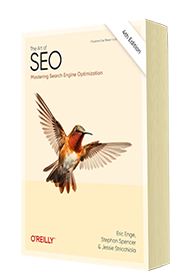SEO: Metrics That Matter
Out with the old, in with the new. In terms of SEO, what’s falling by the wayside?
* Obsessively watching indexation numbers and rankings on “trophy” keywords (like the one you know the CEO always checks first thing in the morning).
* Worrying yourself sick over “duplicate content penalties.”
* Relying on Sitemap XML files to fix your indexation problems (News flash: Your rankings will still stink!).
* Exchanging links.
What’s hot in SEO?
* Truly understanding and leveraging the power of “long tail”dynamics.
* Becoming a trusted contributor within Wikipedia, Digg, StumbleUpon, Netscape and Reddit.
* Building your network in MySpace, Flickr, LinkedIn, YouTube, Bebo, MyBlogRoll and the blogosphere in general, and then reaping the rewards of “network effects.”
* Building custom search engines and rallying your community to help improve it.
* Link baiting.
So how do you measure the impact of this sort of stuff? A new generation of SEO metrics, that’s how. Gauging your success on your positions in the search engine results pages is so last century.
New SEO paradigms, such as the “long tail”and personalized search, call for new key performance indicators (KPIs). In addressing “long tail”SEO specifically, some of my Netconcepts’ colleagues cleverly came up with the following KPIs:
Brand-to-nonbrand Ratio
This is the percentage of your natural search traffic that comes from brand keywords versus nonbrand keywords.
If the ratio is high and most of your traffic is coming from searches for your brand, this signals your SEO is fundamentally broken. The lower the ratio, the more of the “long tail”of natural search you are likely capturing. This metric is an excellent gauge of the success of your optimization initiatives.
Unique Pages
This is the number of unique (non-duplicate) web pages crawled by search engine spiders such as Googlebot.
Your website is like your “virtual sales force” bringing in prospects from the search engines. Think of each unique page as one of your virtual salespeople. The more unique pages you have, the more opportunities you have to sell through the search engines.
Page Yield
This is the percentage of unique pages that yield search-delivered traffic in a given month.
This ratio essentially is a key driver of the length of your “long tail”of natural search. The more pages that yield traffic from search engines, the healthier your SEO program. If you have only a small portion of your website delivering searchers to your door, then most of your pages, your virtual salespeople, are warming the bench instead of working hard for you. My colleague Brian Klais has a name for the webpages that aren’t driving any search traffic, freeloaders.
Keyword Yield
This is the average number of keywords each page (minus the freeloaders) yields in a given month. Put another way, it’s the ratio of keywords to pages yielding search traffic.
The higher your keyword yield, the more of the “long tail”of natural search your site will capture. In other words, the more keywords each yielding page attracts or targets, the longer your tail. So an average of eight search terms per page indicates pages with much broader appeal to the engines than, say, three search terms per page.
The average merchant in our study had 2.4 keywords per page.
Visitors Per Keyword
This is the ratio of search engine delivered visitors to search terms.
This metric indicates how much traffic each keyword drives and is a function of your rankings in the search engine result pages. Put another way, this metric determines the height or thickness of your,long tail.,
The average merchant in our study obtained 1.9 visitors per keyword.
Index-to-crawl Ratio
This is the ratio of pages indexed to unique crawled pages.
If a page gets crawled by Googlebot, that doesn’t guarantee it will show up in Google’s index. A low ratio can mean your site doesn’t carry much weight in Google’s eyes.
Engine Yield
Calculated for each search engine separately, this is how much traffic the engine delivers for every page it crawls.
Each search engine has a different audience size. This metric helps you fairly compare the referral traffic you get from each. In the Netconcepts study, we found that MSN and Yahoo! tend to crawl significantly more pages, but the yield per crawled page from Google is typically significantly higher.
As you optimize your site through multiple iterations, watch the above-mentioned KPIs to ensure you’re heading in the right direction. Those not privy to these metrics will have a much harder time capturing the long tail of SEO.

Chapter 6:
Keyword Research
From the fundamentals of link building to the nuances of natural linking patterns, virality, and authority.
Related Posts

Embrace Journaling, Tackle Tardiness, and Explore Our Energetic Echo
Here’s what I found inspirational, challenging, or just downright hilarious this week. What caught your eye? And, remember to check out this week’s great podcast episodes: Scaling a SaaS Company with Jason Morehouse “A crucial factor to business success is to find and take the personal path that works best for you.” — Jason Morehouse […]
Read More
Harrison’s harmony, conquering a blank canvas, & gut health hacks
Here’s what I found inspirational, challenging, or just downright hilarious this week. What caught your eye? And, remember to check out this week’s great podcast episodes: Be a Sales Game Changer with Fred Diamond “True elite sales professionals develop a dedicated mindset, proactive client interaction, and continuous self-preparation. They understand their client’s needs and enable […]
Read More
Rebirth of sleeper trains, 4,000 weeks is a long/short time, and golden age for medicine
Here’s what I found inspirational, challenging, or just downright hilarious this week. What caught your eye? And, remember to check out this week’s great podcast episodes: A Story Worth Retelling with Luke Storey “Aligned values are the cornerstone of successful partnerships, whether in business or life, as they shape our moral code, define our priorities, […]
Read More
